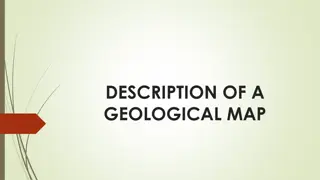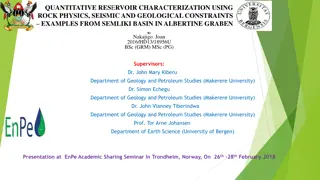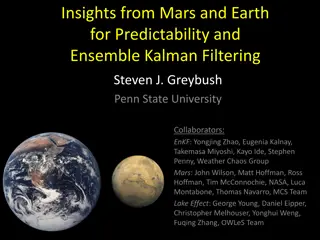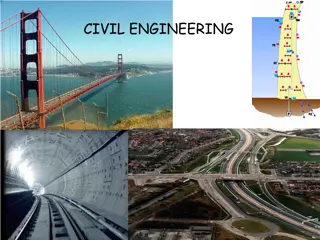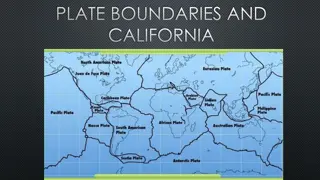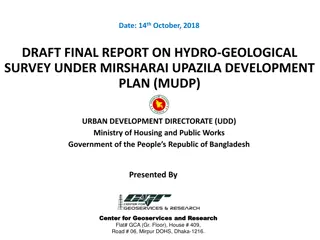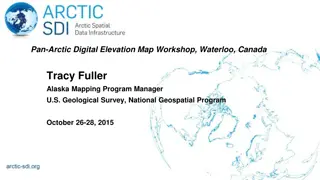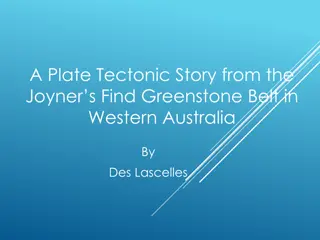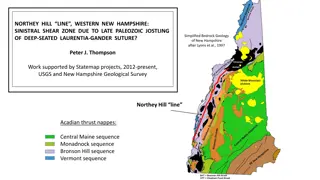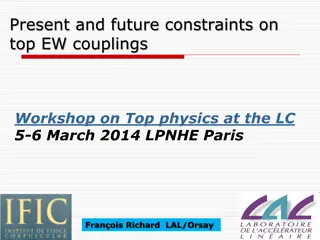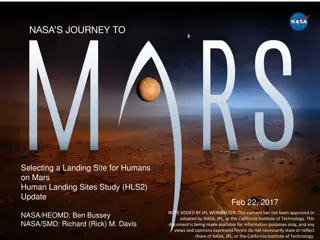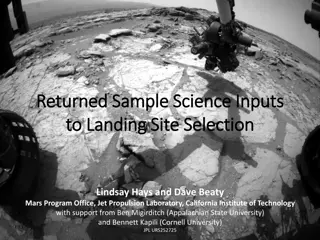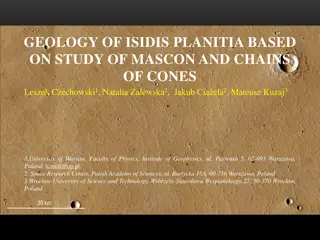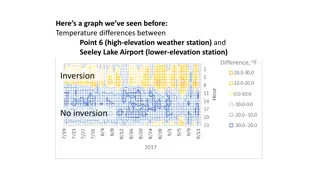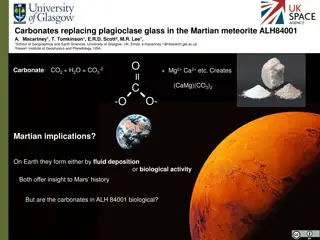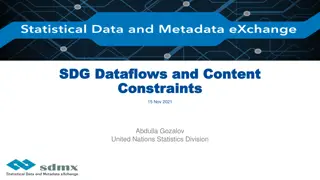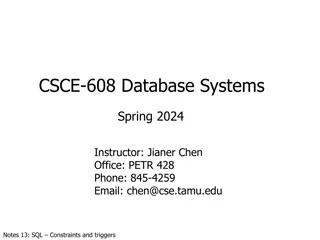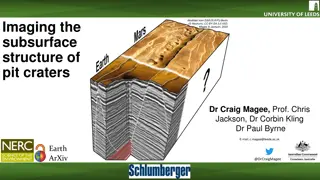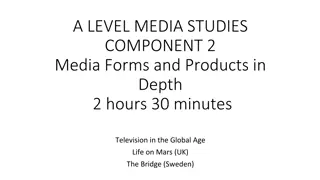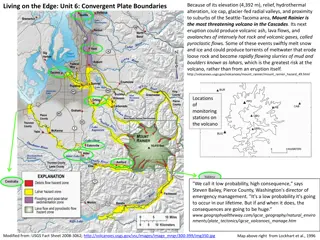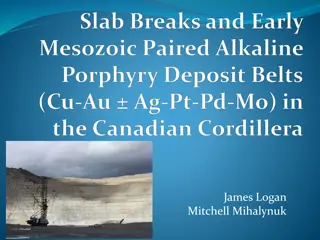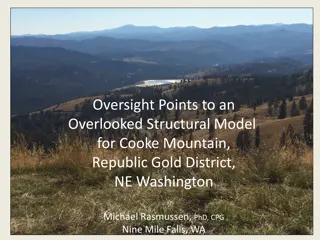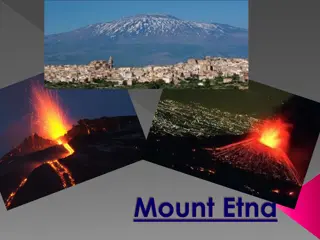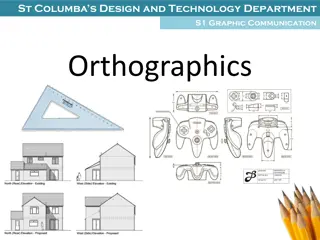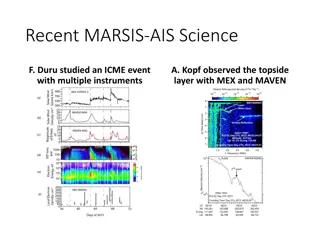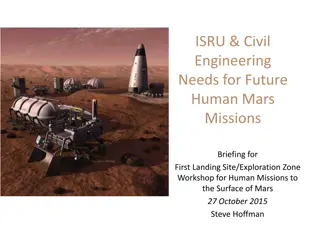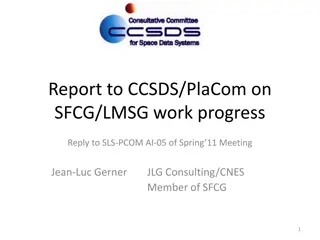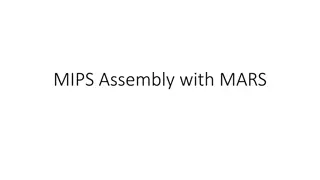Exploring Mars 2020 Elevation Constraints and Geological Features
The content showcases images and information related to the exploration of Mars, focusing on the Nili Fossae Trough site and the unique geological features present. It highlights the diverse materials discovered, elevation challenges, slope characteristics, and the composition of ancient Martian terrains. The content also emphasizes the importance of studying volcanic plains, mineralogic analysis, and the search for evidence of past alteration processes on Mars.
Download Presentation

Please find below an Image/Link to download the presentation.
The content on the website is provided AS IS for your information and personal use only. It may not be sold, licensed, or shared on other websites without obtaining consent from the author. Download presentation by click this link. If you encounter any issues during the download, it is possible that the publisher has removed the file from their server.
E N D
Presentation Transcript
C. Viviano-Beck, A. Brown, E. Amador, J. Mustard, and K. Cannon NOTE ADDED BY JPL WEBMASTER: This content has not been approved or adopted by, NASA, JPL, or the California Institute of Technology. This document is being made available for information purposes only, and any views and opinions expressed herein do not necessarily state or reflect those of NASA, JPL, or the California Institute of Technology.
South of the Nili Fossae Trough site Within Mars 2020 elevation constraints Stratigraphy similar to that exposed in the north; includes strong carbonate signature Cache significantly diverse material that is in-place (known context)
Elevation: Relatively low slope to drive out of trough and access phyllosilicates and plateau
0 5 10 15 20 25 MOLA slope:
MAF CRISM (FRT & HRL) HiRISE
MAF Land-on unaltered volcanic Hesperian plains (age-dating) Evolving primary compositions? Olivine(OLINDEX3) LCP(LCPINDEX2) HCP(HCPINDEX2)
IR Albedo MAF OLINDEX3 LCPINDEX2 HCPINDEX2 R1330
BD1900R2 D2300 BD1400 OLINDEX3 LCPINDEX2 HCPINDEX2
300 m ESP_016496_2000 Fan?/debris flow?
300 m ESP_016496_2000 Fan?/debris flow?
Land-on in place unaltered volcanic Hesperian plains (age-dating) Hesperian flow characteristics (magmatic evolution of Syrtis Major through mineralogic/elemental analysis, flow layers/thickness with GPR) Ancient Noachian LCP-bearing material (ancient crust composition, mineralogic/elemental analysis) Determine composition of Noachian alteration material (constrain alteration temperature, fluid composition, pH, etc.)
Exposed contact between altered and unaltered material Alteration
PFM IR Albedo BD2355 D2300 BD2290 OLINDEX3 BD1900R2 D2300 BD1900R2 D2300 BD1400 R1330
Laboratory Reflectance BD1900R2 D2300 BD1400
Hydration variability? 2.39 m variability Possible carbonate component BD1900R2 D2300 BD1400
BD1900R2 D2300 BD1400 150 m ESP_016496_2000 Mg-OH bearing layered material below plateau
BD1900R2 D2300 BD1400 50 m Mg-OH bearing layered material below plateau
BD1900R2 D2300 BD1400 100 m ESP_016496_2000 Mg-OH bearing mega-breccia
Discernable contact between unaltered and altered Noachian material (test formation hypotheses) Compositional stratigraphy of altered material, carbonate component? (diverse alteration conditions, temperature/pH/fluid gradients > energy gradient) Hydration state of phyllosilicates (human resource) Layered alteration material at the top of the stack (sedimentary? changing formation mechanism?) Possibility of mega-breccia provides even more potential diversity Contact between Syrtis flows and plateau material - nature of Fossae faulting (GPR)
Carbonate abundance (CO2 sequestration/cycling) IR Albedo MIN2295_2489 MIN2345_2537 D2300 R1330
Pedogenesis? IR Albedo BD2165 BD2190 MIN2200 R1330
50 m ESP_016496_2000 BD1900R2 D2300 BD1400 Erosionally-resistant fracture fill
In place Noachian LCP-bearing material (ancient crust composition, mineralogic/elemental analysis) Variety of alteration conditions (hydrothermal fluid, mineralization along fractures) Olivine-carbonate(-talc?) assemblage (test talc hypothesis: increased Si activity may help preserve biosignature-silicification, exothermic long-lived rxn) Kaolinite-bearing material may record pedogenic sequence
Olivine and LCP-rich material Altered/LCP flow HCP flow
Kaolinite Carbonate Fractures Layers Compositional stratigraphy
Kaolinite Olivine- carbonate Phyllo. Strat. Phyllo. layers Debris flow/fan Fractures
Environmental Setting for Biosignature Preservation and Taphonomy of Organics Type 1A & 1B Samples: Aqueous Geochemical Environments indicated by Mineral Assemblages Type 2 Samples: Igneous Context: Martian History Sampled, Timing Constraints Landing Site Factor Igneous unit (e.g, lava flow, Dateable surface, volcanic No diagenetic overprinting Stratigrapy of units well- Hydrothermal (<100 C) Hydrothermal (<100 C) (unmodified crater SFD) Ferric Ox./Ferrous clays Pre- or Early-Noachian Lacustrine (evaporitic) Youngest stratigraphic Al clays in stratigraphy Crustal phyllosilicates pyroclastic, intrusive) Deltaic or Lacustrine Oldest stratigraphic Chloride sediments Sedimentary clays Sulfate sediments Acid sulfate units 2nd Igneous unit Recent exposure Carbonate units Fluvial/Alluvial Silica deposits Megabreccia (perennial) subsurface constraint Pedogenic constraint defined surface S. Nili Trough ~ ~ ~ ~ EN EH Kaolinite over Fe/Mg- phyllo. Stratigraphy mostly outside Resistant fractures may be With phyllo. and olivine- Olivine-carbonate(-talc) Phyllosilicate-bearing Olivine and LCP units carbonate in plateau Layered phyllo. Layered phyllo. Debris flow/fan silica-bearing Syrtis flows Syrtis flows Syrtis flows Kaolinite LCP+clay ellipse Isidis


